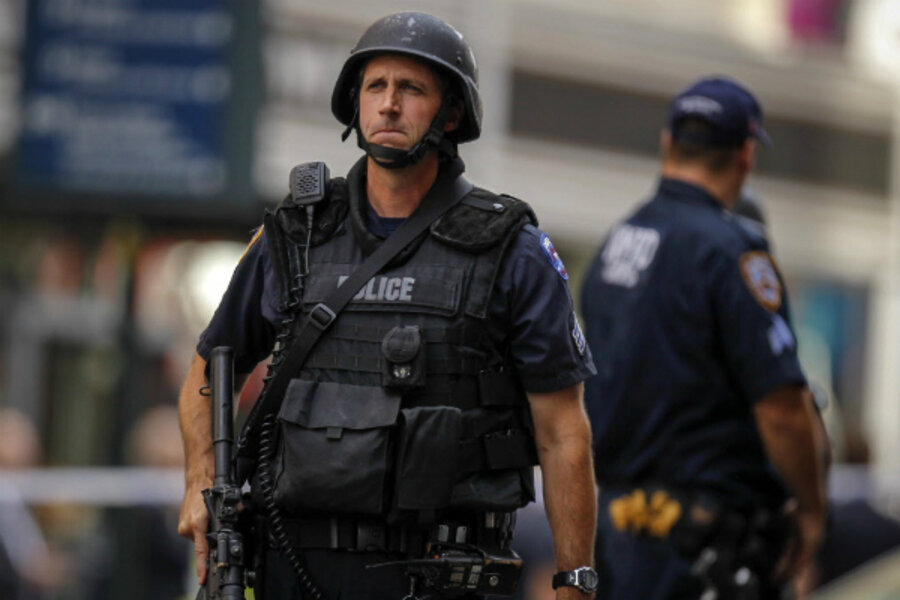Behind Empire State shooting: A layoff, a gun, and a targeted ex-boss
Loading...
| New York
The street shooting Friday morning near New York's landmark Empire State Building, in which an ex-employee killed his former boss, is a tragic reminder that workplace-related violence remains a consistent, if sporadic, problem – one that more American companies have sought to address by adopting more humane firing policies.
The shooter, who was killed by police officers as he tried to leave the scene, has been identified as Jeffrey Johnson, 58. Authorities say he lost his job with Hazan Imports, which imports budget women's purses, about a year ago when the company downsized.
Although Mr. Johnson apparently targeted one individual, chaos ensued in the Empire State Building vicinity, a major New York tourist district, as police confronted him and, when he pulled his gun, fired in his direction, killing him. Nine bystanders were wounded, either caught in the line of fire or hit by richoceting bullets.
By 11:30 a.m., New York Mayor Michael Bloomberg and New York Police Commissioner Ray Kelly were briefing the media and reassuring the public that the shooting was not a terrorism incident and that New York is a safe place – including the Empire State building’s observation deck. According to Mr. Bloomberg, all the people injured will survive.
Although incidents of workplace violence crop up periodically, there is no evidence that they have escalated during the recent economic downturn and continuing doldrums, when millions of American workers lost their jobs. There were 432 homicides in the workplace in 2010, down from 462 in 2009, and the number has been pretty flat over a seven-year period, according to the Bureau of Labor Statistics.
“In the early 1990s, there was an outbreak of workplace shootings, and as a result bosses and supervisors became very insecure and for the sake of personal safety decided to use more humane firing practices to protect themselves,” says Jack Levin, a professor of sociology and criminology at Northeastern University in Boston.
Most large companies have an established policy for firing workers, says employment expert Chris Lawson, CEO of Eli Daniel Group in Dallas, a staffing company. “The HR department has you come in and sit down, they walk you to your desk, let you get your belongings, and walk out calmly with you,” he says. “We know it’s emotional, and people get blind-sided all the time.”
Smaller companies, he says, often don’t have much expertise with firing employees. “In reality, there are managers across the country who are not properly trained in how to manage the termination process,” he says. “The last thing you want to do is send someone out the door in a fit of rage.”
At this stage of the investigation into Friday's shooting, it's not clear why Mr. Johnson shot his former boss, a vice president of sales for Hazan, or why he acted now. A usual motive in such cases, say experts on violence in the workplace, is revenge.
“There is almost always a precipitant,” says Mr. Levin. “It’s usually the loss of a job, or it could be that someone is owed a lot of money.”
The case involving Johnson is unusual, in that he was 58 years old, says Raymond DiGiuseppe, chairman of the psychology department at St. John’s University in New York. “As people get older, there is a drop in aggression,” he says. “For someone at this stage, [a shooting] is unusual.”
Mr. DiGiuseppe guesses that Johnson might have been stewing over a perceived mistreatment for some time. “He had to plan it a little bit," he says. "It is unlikely this guy had a gun lying around; he probably had to go out and get it.”
Levin suspects that Johnson may have decided that life was not worth living. “He committed 'suicide by cop.' He knew that if he did not drop his weapon, they will drop him – and that was part of his plan,” suggests Levin.
The New York Police Department will have ample opportunity to discover if that’s the case. Police Commissioner Kelly said the incident was captured on security cameras.







